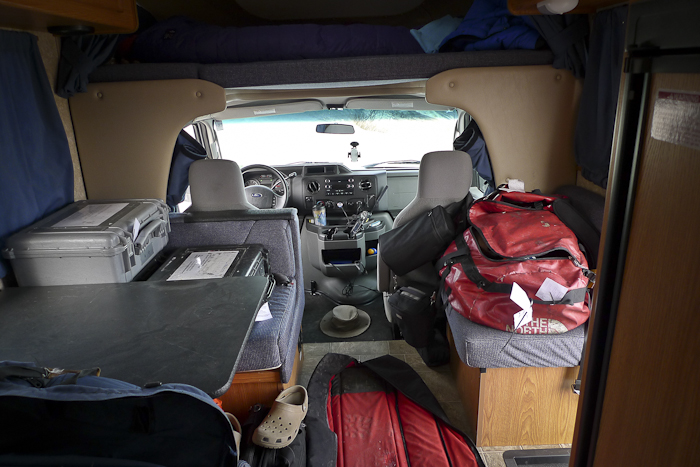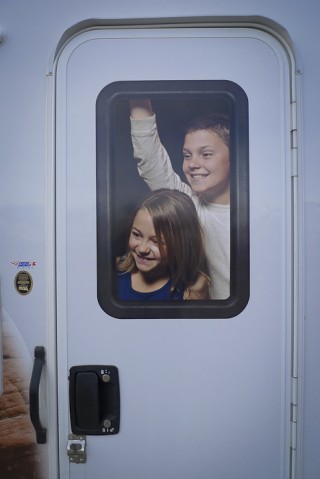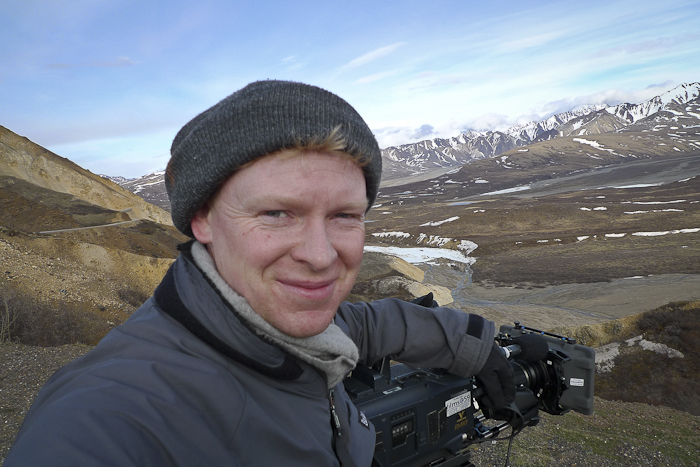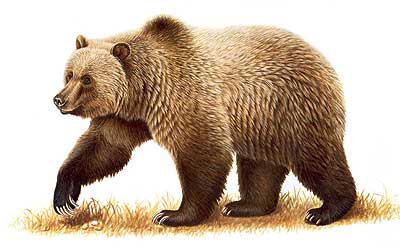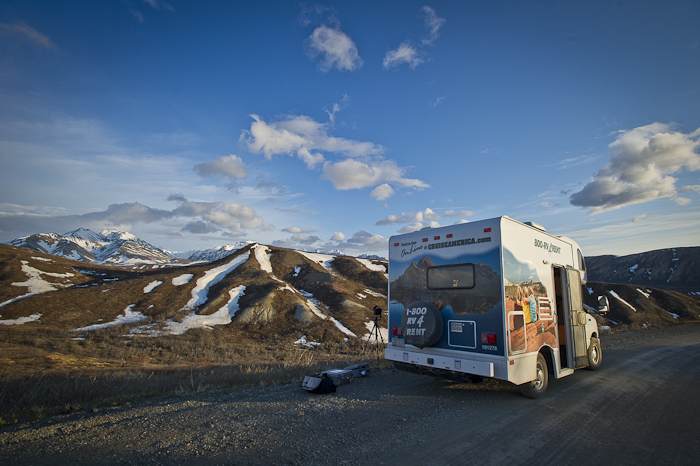 Finally home from the Great Alaskan Road Trip. It felt like (and was) a pretty long shoot, just under five weeks. All in all it was good, we got some great filming done although is was tough going for the most part, not least due to the fact that it’s difficult to know exactly when to stop working when there are 19 hrs of daylight each day and the best light is often at 10.30pm – when you should be tucked up in bed!
Finally home from the Great Alaskan Road Trip. It felt like (and was) a pretty long shoot, just under five weeks. All in all it was good, we got some great filming done although is was tough going for the most part, not least due to the fact that it’s difficult to know exactly when to stop working when there are 19 hrs of daylight each day and the best light is often at 10.30pm – when you should be tucked up in bed!
The first 10 days I was up in Denali National Park based out of a camper van which was fantastic fun – never having even set foot in a camper van before everything was rather new but I think we got on rather well. There was plenty of room (if you didn’t mind climbing over camera cases the whole time) and it’s pretty amazing to have the option of setting a couple of timelapses running and then go inside and have a hot shower and cook a meal. The plus side was that you always had everything with you – none of the dashing back to the hotel because you’ve forgotten some batteries, and you could have a snooze anywhere you liked – although inevitably if you found a quiet spot to pull off the road a park ranger would come and ask you what you were doing and / or an irate tour bus driver would insist that you were in the exact spot where he / she might need to turn round. The Denali bus drivers are a rather special breed – I hope they are genuinely happier with their lives than they outwardly appeared.
The down sides to the camper van are a) you look like an idiot driving around in this ridiculous machine covered in dumb graphics b) they do about 20ft to the gallon which is not nice for the environment and means that you are constantly planning ahead to figure out when you need to fill up again. Other than that it’s a very neat way of filming.
Denali its-self was incredible, and has definitely become one of my top 10 locations on the planet. The landscape is on a breathtaking scale – it feels like you are in the pleistocene and that a herd of wooly mammoths could come trundling over the hill at any moment, and Denali (the mountain after which the park is named, and the highest peak in North America) is an absolutely vast lump of rock, it’s often hidden by cloud but when it puts in an appearance it dwarfs everything around it. The wildlife is fabulous too, I saw wolf, caribou, brown bear, lynx, moose, golden eagle and got some good filming done.
Sadly the main wolf pack – the Grant Creek Pack – has been severely disrupted by the death of the alpha female (trapped on the park border by a hunter) and the pack’s oldest female who died during the winter – they weren’t denning at their usual site, if at all, and I only saw one individual when they are usually pretty conspicuous along the park road. The brown bears were great and the scenery fantastic. I was lucky to be their just at the start of the tourist season and had a few days in the park before the tour busses start running – once they do start the effect on the wildlife is rather pronounced and animals appeared to me to be rather stressed by their constant presence – I can’t think of another way of large numbers of people to experience the park though so it’s a tough one.
After Denali it was back down to Anchorage for 10 days of trying to track down moose, black bears and to film the King Salmon run. I was working with my old friends Rick and Jessy from the Alaska Department of Fish & Game, essentially trying to do much of the same sorts of things I’d done 6 years ago when I made ‘Moose on the Loose’. It was interesting how much has changed with Anchorage’s urban wildlife; the garbage situation (which was causing all sorts of problems with black bears) is under much better control with people being fined $300 if bears get into their garbage. In many hours of driving around with Rick we never saw a single bear eating trash, or even a single bin bag that had been opened by a bear. 6 years ago evidence of bear action was easy to find, and you could often follow the trail of strewn rubbish to a bear with its nose in a bin. The moose also seemed much harder to find, especially cows with calves, possibly the record setting tough winter had killed a proportion of pregnant females or caused them to re-absorb their foetus’s. Worst of all was the almost complete failure of the King Salmon run. These spectacular fish can grow to over 40lbs and typically thousands of them run up through the rivers and creeks that drain through the city – it’s a spectacular site – and you can have hundreds of fishermen standing shoulder to shoulder trying to catch them. This year there where practically none, at first it looked like the huge amount of snowmelt was making the river water too cold and the fish were waiting out at sea, and maybe the run would just be late, but as time went on it became apparent that something serious has happened. Salmon run numbers are cyclical, but its really unsettling to think that there may be environmental issues out at sea that are causing such a catastrophic drop in fish numbers.
The Anchorage filming, although I got some really nice stuff, was very tough going, so the last week was the perfect antidote. Sarah, the film’s fantastic and long suffering researcher came out and we headed down to the Katmai peninsula, to a place called Hallo Bay, which is famous for its brown bear viewing. We had a week at the Hallo Bay camp, a really well run low-impact outfit set just back from the shoreline of the bay. There were plenty of bears and virtually wall to wall sunshine and we got some great footage. We should have been their for peak mating season but – again probably due to the slightly unusual weather – it seemed that most mating activity was already over, so the bears had settled into a routine of feeding on sedge grass, clams and taking extended naps, biding their time before the summer’s big event of the August salmon run kicks off. My favorite bit was filming the bears feeding on clams, they would wander the mud flats at low tide with thier muzzles inches from the wet sand and as soon as they sensed a clam they would dig down with those massive paws to grab these little 2 inch long clams, they would then delicately prize open the shell and squeeze the contents onto the fur of their forearms (so as not to get the clam meat fouled by sand) then lick it off, fantastic.
So a long trip, hard work but with some really nice footage to show for it. It was so good to get back home Max & Felix had really grown – and it’s lovely to be back at the heart of it all. I’m off to Zambia on Sunday for a month – a horribly quick turnaround between two long trips, but I think we’re all just looking forward to our holiday in August.
